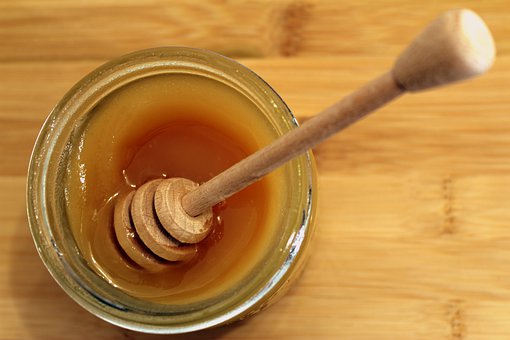This post contains affiliate links.
This post will answer some frequently asked questions about what is honey.
Is Honey Bee Poop?
Honey is not bee poop, bee vomit, bee spit, or bee wax.
Honey is the end product of bees gathering nectar from flowers and distilling the nectar through enzymatic reaction and dehydration into honey.
Bee Poop
Bee poop called frass is the undigested remnants of pollen and metabolic remains of digested honey that are passed through the honeybee’s intestinal system and excreted as poop, just like a human’s intestinal system.
Unlike the human, a honeybee adds its waste liquid, pee, with the solid excrement and that is all excreted through the honeybee’s rectum, the terminal end of the honeybee’s hindgut, the ileum.
The ileum is where most of the water is reabsorbed leaving mostly uric acid as the discarded portion of consumed water.
This process allows the honeybee to consume much less water, unlike the human that excretes uric acid through urination which requires changing the ph of the urea acid by adding water to the urine.
In humans, this is controlled by the kidneys.
Honeybees do not have kidneys.
Bee Vomit
Honeybees do not have a digestive stomach.
Nutritional intake passes from the honeybee’s mouth directly into its intestine for digestion and there is no mechanism for regurgitation once food enters the honeybee’s intestine.
Bee Spit
Bee spit is a nondescript term that could be one of two things, saliva or water for transport:
Saliva
Honeybee saliva, secreted by the honeybee’s salivary glands contains a small amount of water and two enzymes, diastase and glucose oxidase.
The enzymes diastase and glucose oxidase are retained in the “crop’ or “honey stomach” of the honeybee to enzymatically process the collected flower nectar as it is being transported from the flower to its final destination of a honey cell deep within the totally dark bee hive.
Water Transport
Female honeybee workers in the field are tasked with one of two objectives:
- Collect flower nectar and pollen.
- Collect water.
These are two separate tasks but both water and nectar are transported to the bee hive in the “crop” or “honey stomach” of the bee.
Water is collected by the “field” female honeybee, collecting the water, storing it in her “crop” and transporting the water back to the beehive, transfers the water to a “hive worker” bee through a direct bee-to-bee transfer called trophallaxis.
The water is then distributed throughout the hive for drinking water but is used primarily for evaporation and cooling of the bee hive by fanning of bee wings.
Pollen would not be part of bee spit.
Polen is collected and transported on the legs of the honeybee.
Honey bees derive their protein nutrition from pollen. They carry pollen back to the nest within specially arranged hairs on their legs called “pollen baskets.”
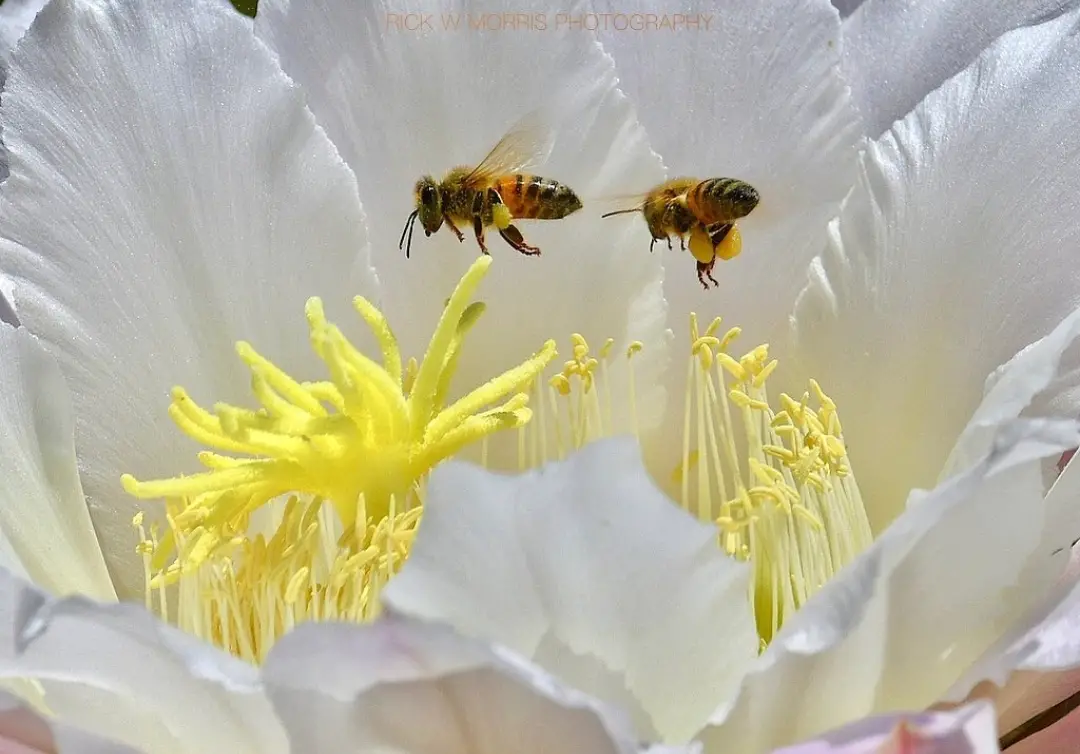
She’s ready to head back to the hive.
Photo By: Rick Morris
Bee Wax
On the honeybee’s abdomen are specialized cells called “wax mirrors”
These cells secrete wax which honeybees scrape off their bodies with their legs and build the honeycombs within the bee hive.
These honeycomb cells are architecturally designed differently to be used for raising drone honeybees, raising female worker bees, storing pollen, and storing honey.
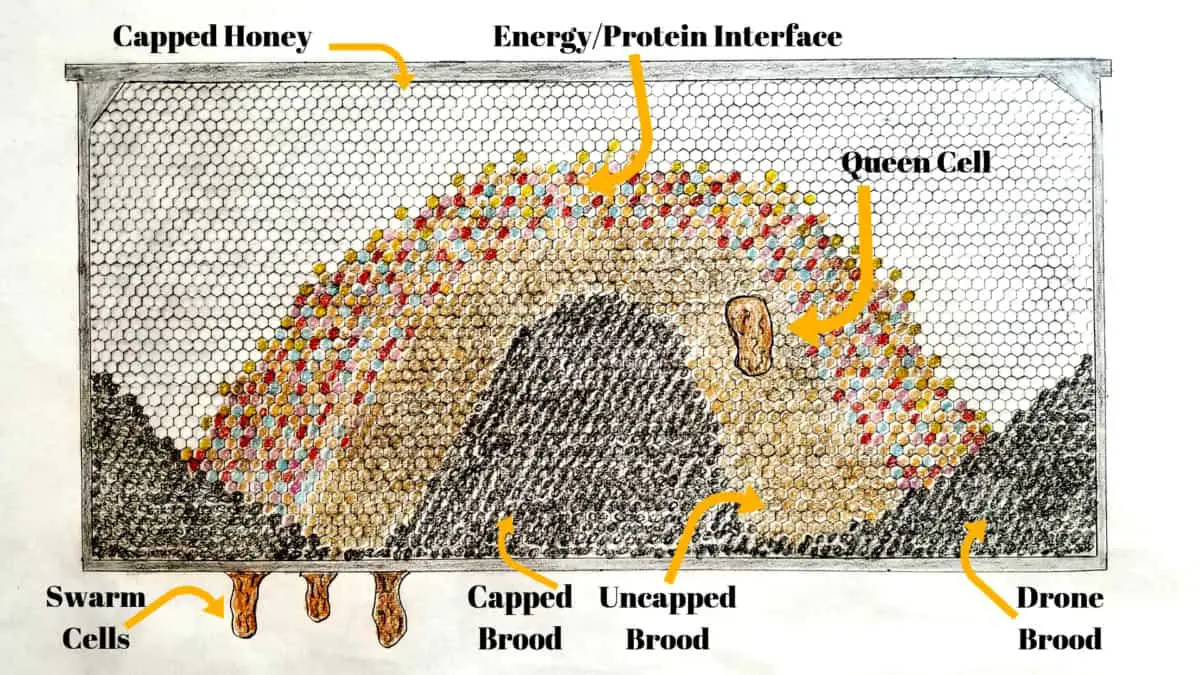
In real honey, there will be some remnants of the honeycomb wax within the honey giving it the cloudy appearance absence in fake or highly processed honey.
See my article: Real vs Fake Honey: 17 DIY Home Tests
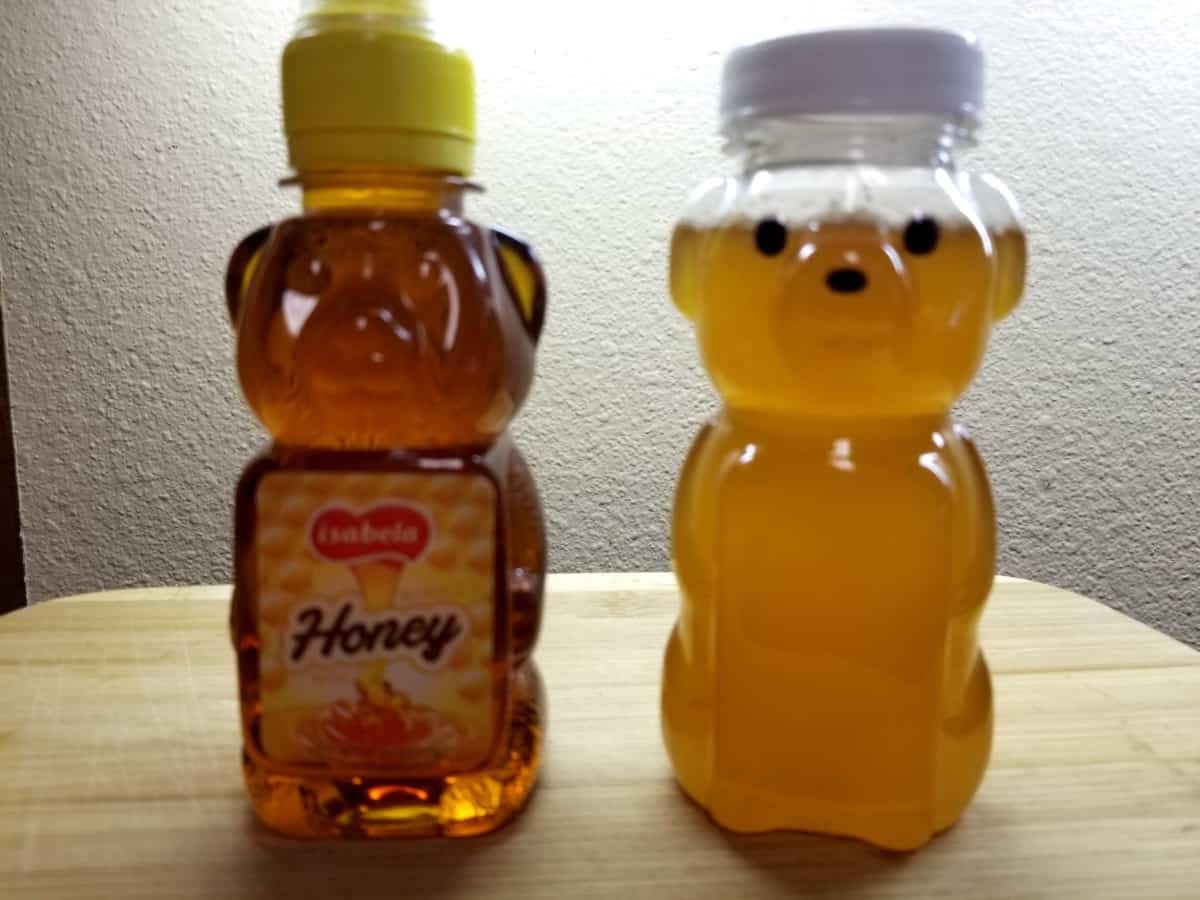
What Is Honey?
Honey is a combination of 40% fructose, 30%glucose, less than 18% water, about 25 additional oligosaccharides, and some trace minerals and vitamins.
Honey is the end product of the symbiotic relationship between nectar-producing flowering plants and honey bees.
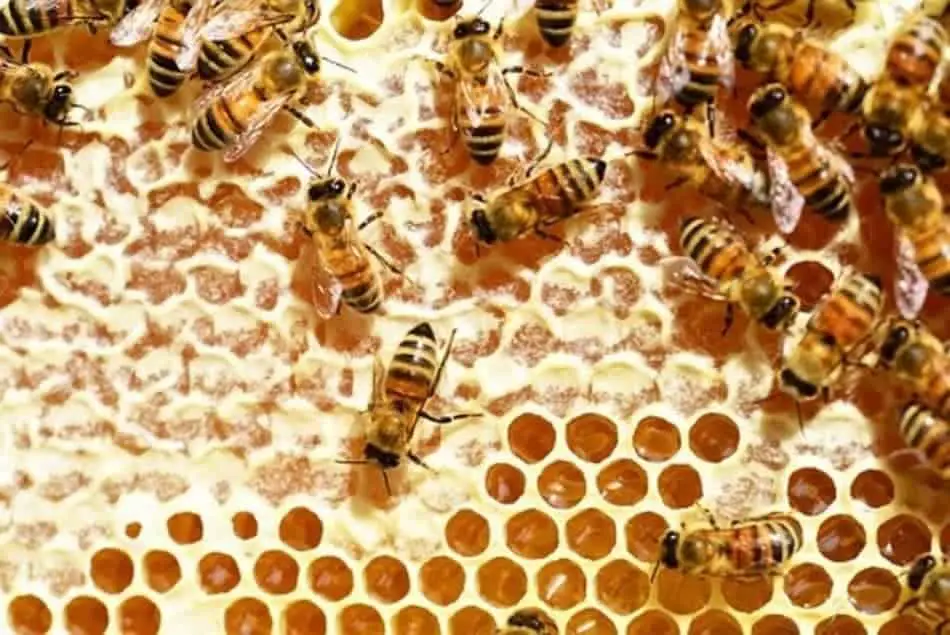
Yellow is not dehydrated enough to be honey yet.
Honey bees gather the nectar and then process the nectar through enzymatic and dehydration techniques into the final product known as honey.
Fructose and glucose are monosaccharides, meaning they contain only one type of sugar, also known as “simple sugar”.
Honey typically has more fructose (40%) than glucose (30%) with the remaining 17% being water.
Glucose and fructose can also be manufactured by the human body through the consumption of carbohydrates, primarily vegetables, and fructose through the consumption of fruits.
Additionally, honey contains about 25 oligosaccharides (molecules that contain more than 1 sugar unit), and a trace amount of vitamins and minerals.
Glycation is the binding of a sugar molecule (glucose or fructose) with a lipid (fat) or protein, and nerve sheths are made of lipids and proteins.
Nerve sheths are what allow the nerve to transmit electrical impulses to the brain quickly.
When glucose or fructose binds to nerve sheets it is called glycation, and distal, smaller nerve sheaths are affected first.
An individual diagnosed with peripheral neuropathy is the result from the distal peripheral nerve endings having become glycated and causing symptoms like numbness or pain, usually in the toes and feet first.
Both glucose and fructose cause glycation of peripheral nerves, however, fructose causes this glycation of nerve sheaths more quickly than glucose.
How Is Honey Made?
Female honeybees gather nectar from flowers, bring it back to the hive where other female bees receive the raw nectar, mix it with special enzymatic processes, then deposit it into a honeycomb cell where still other females fan it into a dehydration concentration of 18% or less, then caps honey off with wax.
Honey bees gather the nectar from flowers and store it in a “second stomach” called a “crop” or “honey stomach”. The nectar mixes with enzymes in the bee’s crop as the bee flies around gathering more nectar.
When the bee can no longer take on more nectar it heads back to the hive where it transfers its “crop/honey stomach” content into the “crop/honey stomach” of another worker bee stationed within the hive.
That hive worker honeybee then transports its “crop/honey stomach” nectar deep into the hive in total darkness and injects this mixture into a cell of a honeycomb.
Once this mixture is in the honeycomb, other worker bees fan their wings until the mixture becomes a viscous thick dehydrated fluid.
When the mixture reaches a water content of 18% or less it is now called honey and worker bees seal off the honeycomb cell with wax for storage; it can last for millenniums!
See my article: Real vs Fake Honey: 17 DIY Home Tests
Where does honey come out of a bee?
Honeybees do not excrete honey from any honeybee orifice.
Honeybees gather nectar from flowers and transport the nectar to the beehive in their “crop” or “honey Stomach” where the nectar, through enzymatic processing and evaporation dehydration to a water content of 18% or less, is transferred into honey.
Is there bee poop in honey?
There is no bee poop in honey with the possible rare exception of honey being harvested from an infected beehive with diarrhea, or honey that has been extracted from a brood frame.
Honeybees are insects that keep their hive meticulously clean.
In fact, the first job of a newly birthed honeybee is to clean up its own birthing cell in preparation for the Queen bee to lay another egg in that same cell.
The Queen bee does poop inside the hive as she never leaves the hive after her maiden flight for sperm collection. All her excrement is gathered by an entourage of hive worker bees and transported out of the hive.
The Queen bee is constantly surrounded by her entourage and her every need is attended to immediately.
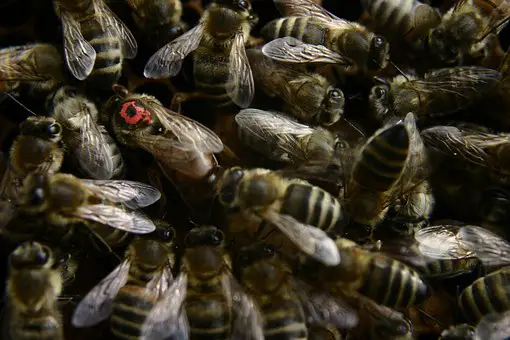
Beekeepers confine the Queen bee to the “brood box” of the hive, where she is allowed to deposit her fertilized eggs in this “brood box” to replenish the bee hive’s population.
This confinement is accomplished by using a “Queen excluder screen” in which the Queen is too large to migrate into the taller towers of the bee hive, the “honey supers”, where excess honey is stored.
Honey frames in the “honey supers” are the frames of honey that beekeepers harvest. They contain pure honey with no bee poop or debris in the honey.
See my article: Adding Honey Beehive Supers: (When and Where)
All hive worker bees leave the hive occasionally for a “cleansing run”.
Honey bees have the extraordinary ability to hold their poop for a very long time.
In the cold winter months, they may not leave the hive for a “cleansing run” for weeks
In cold months the honeybee may poop as close as 50 feet away from the hive, but in warmer weather, they will poop much further away.
Nectar-gathering worker bees will poop as they feel the need as they fly far away from the hive every day it is warm enough to fly.
How Does The Honeybee / Flowering Plant Symbiotic Relationship Work?
Flowering plants produce nectar and pollen.
The flowering plant needs the pollen to be transported to a different flower for the purpose of fertilization.
The flowering plant produces nectar to attract the bees.
The bee collects the nectar as well as the pollen.
The hive needs both the nectar to make honey and the pollen to eat for protein.
The pollen is essential for making Royal Jelly, the only food source of the Queen bee and also the food required to feed newly developing honeybees known as the “brood” in the first three days of development.
See my article: Royal Jelly: The Honeybee’s Birth To Death Life Path Coach
During the bee’s collection of nectar and pollen, moving flower to flower, some of the pollen carried on the bee’s legs rubs off onto the flower’s stamen thereby fertilizing the plant, a necessary process that allows the plant to produce seeds.
See my article: What is the importance of beekeeping?
Thanks for reading my article, I appreciate your time.
I hope the article has answered your questions.
Paying It Forward
Backyard Visitors participates in affiliate programs which compensate us for referring traffic.

